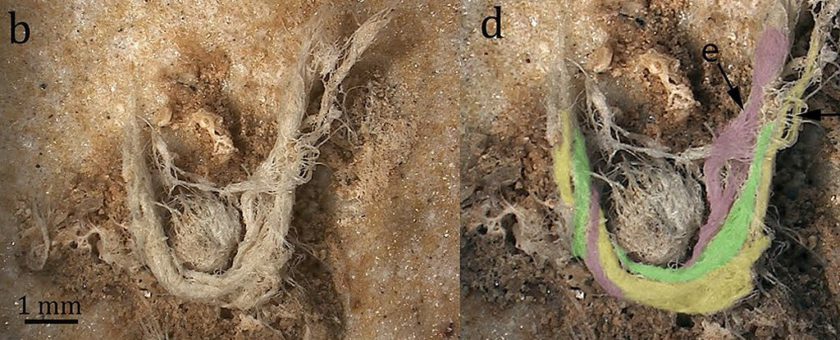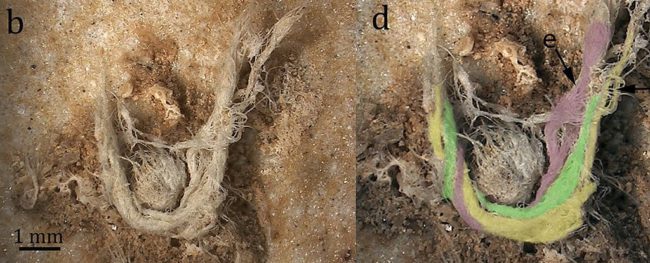
Asking such a question about string sounds trivial and a not very useful question to ask, but behind it resides an insight into something truly fascinating.
Key bit of news
So how old is the oldest piece of string ever discovered?
Up until recently the record was a 19,000-year-old fragment found in Israel. That however has changed.
Researchers have found a 6.2 millimetre (0.24 inch) fibre fragment which they date to around 41,000–52,000 years ago.
Here comes the insight. It was not made by humans. This is a discovery that was made in a cave in France, which would’ve been a Neanderthal settlement at the time. It suggests that they were smarter and more adept at crafts than we often give them credit for.
The Insights this Discovery brings changes our understanding of the Neanderthal mind
“Understanding and use of twisted fibres implies the use of complex multi-component technology as well as a mathematical understanding of pairs, sets, and numbers,” write the researchers in their published paper.
“Added to recent evidence of birch bark tar, art, and shell beads, the idea that Neanderthals were cognitively inferior to modern humans is becoming increasingly untenable.”
Taking a Closer Look
After discovering the fragment, the researchers used spectroscopy and microscopy techniques to analyse it and determine where the fibres had originally come from – probably the inner bark of a non-flowering tree, such as a conifer, before it hardened.
The team suggests that we have a poor understanding of the Neanderthals because perishable materials like this are usually long gone by the time we get to them. Tools and bones can only tell us so much.
If these ancient hominids were indeed able to make string, they would have had to know about the growth and seasonality of the trees the fibres were taken from, and been able to apply some numeracy skills to twist and bundle the fibres up into yarn.
In other words, making fibres and string is more complicated than you might realise. The researchers think the fragment they’ve discovered might have been a handle for the flint tool it was attached to, or part of a net or a bag for holding tools.
And this goes way beyond a bit of string. Once you can make a cord like this, it’s not a huge leap to making fabric, baskets, mats and even boats. Again, the inference is that Neanderthals and their societies were more sophisticated than we give them credit for.
“The cognitive abilities for making string and rope are very similar to those for making language,” anthropologist Bruce Hardy, from Kenyon College, told George Dvorsky at Gizmodo. “This speaks to the cognitive abilities of Neanderthals.”
Where exactly was this discovered?
Abri du Maras. It is located in a valley near the Ardèche River, a tributary of the Rhône River in France …
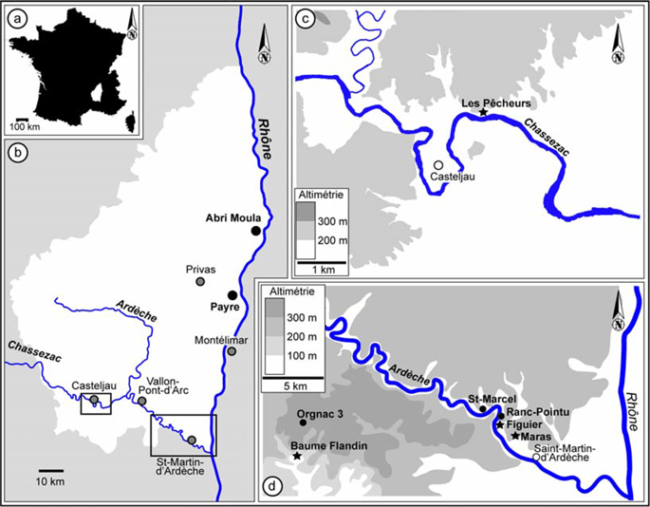
The artefact, with the adhering cord fragment, was found in situ in level 4.2, 3 meters below the modern surface by the director of the excavations (M.-H. Moncel).
The 3-ply cordage fragment was adhering to a stone tool (flake). The flake (G8 128) is a Levallois flake 60 mm long.
The cord fragment was found on the inferior surface of the flake, meaning that the cord fragment entered the deposit contemporaneous with or before the flake. There is no evidence of a burrow or den or other disturbance to the sediment in the well-preserved stratigraphic sequence. Upon excavation, the artefact was immediately placed, unwashed, in a zip-style plastic bag where it remained until microscopic examination. This careful treatment of the artefact precludes further modern contamination.
This is not the first example – other hints exist
Previously, individual twisted plant fibres, some of which were multicellular, were reported on stone tools from Abri du Maras. The authors of the published paper suggested that these might be remnants of cordage, but the remains were too fragmentary to be conclusive.
Are they convinced the cord is not from later humans?
Basically yes.
The flake (referred to as sample G8 128) was recovered in situ with the cord adhering to its inferior surface and was covered by sediment and breccia, demonstrating that the cord is at least contemporary with the deposition and burial of the flake and is therefore Middle Paleolithic in origin.
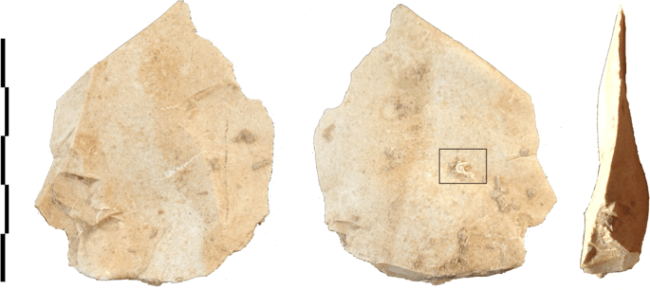
What exactly is this string made of?
The specimen was imaged using an environmental SEM imaging platform of the National Museum of Natural History (MNHN, Paris) and a Hirox 2D/3D digital microscope at the Centre for Research and Restoration of the Museums of France (C2RMF, Paris)
Based on the presence of bordered pits with torus-margo membranes which are arranged in parallel lines, the fibres resemble gymnosperm (conifer) and come from the inner bark. The torus is surrounded by a margo that controls the pressure in the conifer water transport system,; this mechanism is a strategy that distinguishes gymnosperm from angiosperm (flowering plants). Juniper, spruce, cedar, and pine bast have been used archaeologically and historically in the manufacture of cordage and textiles (see Supplemental Information). The presence of pine at the Abri du Maras is confirmed through palynological and charcoal analysis.
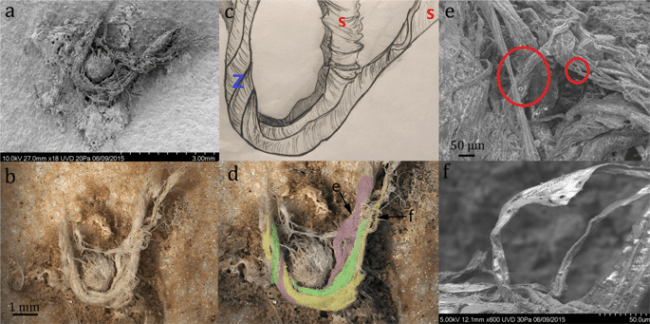
They also collected modern fibre samples from 18 materials that were present during the excavations and examined them microscopically. None of these matched the fibres from sample G8 128
What do the researchers conclude from this?
Direct from the paper …
While it is clear that the cord from Abri du Maras demonstrates Neanderthals’ ability to manufacture cordage, it hints at a much larger fibre technology. Once the production of a twisted, plied cord has been accomplished it is possible to manufacture bags, mats, nets, fabric, baskets, structures, snares, and even watercraft3,4,32. The cord from Abri du Maras consists of fibres derived from the inner bark of gymnosperms, likely conifers. The fibrous layer of the inner bark is referred to as bast and eventually hardens to form bark. In order to make cordage, Neanderthals had extensive knowledge of the growth and seasonality of these trees. Bast fibres are easier to separate from the bark and the underlying wood in early spring as the sap begins to rise. The fibres increase in size and thickness as growth continues. The best times for harvesting bast fibres would be from early spring to early summer. Once bark is removed from the tree, beating can help separate the bast fibres from the bark. Additionally, retting the fibres by soaking in water aids in their separation and can soften and improve the quality of the bast. The bast must then be separated into strands and can be twisted into cordage4. In this case, three groups of fibres were separated and twisted clockwise (s-twist). Once twisted the strands were twined counterclockwise (Z-twist) to form a cord.
Ropes and baskets are central to a large number of human activities. They facilitate the transport and storage of foodstuffs, aid in the design of complex tools (hafts, fishing, navigation) or objects (art, decoration). The technological and artistic applications of twisted fibre technologies are vast. Once adopted, fibre technology would have been indispensable and would have been a part of everyday life. In reconstructing land use patterns, paleoanthropologists typically give priority to activities such as hunting and acquiring lithic raw material. Fibre acquisition, processing, and production may have also played an important role in scheduling daily and seasonal activities. String and rope manufacture are time intensive activities and large amounts of string are required for the production of carrying objects such as bags. In an ethnomathematical study of the Maya, Chahine33 found that a 1.3 foot Maguey bag required over 400 meters of cordage.
Thinking of the environment as including both natural and anthropogenic objects makes it possible to ask several questions about the choices made by cultural groups. Topography, climate, and distribution of plant and animal species are all key factors to consider. Plants play an important role not only in the material conception of objects but also in the formation of the thought of a culture, its representation of the world and its cosmogony4.
Overall, cordage manufacture has a complex chaîne operatoire. Although wooden artefacts are rare, other finds attest to Neanderthals detailed knowledge of trees. They chose boxwood for its density and used fire in the production of “digging sticks” at Poggetti Vecchi approximately 175 ka2. In the construction of the Schöningen spears, they decentered the point to increase strength1. Furthermore, Neanderthals were manufacturing birch bark tar in the Middle Pleistocene of Italy34 and at the sites of Konigsaue35 and Inden-Altdorf in Germany36. Based on this evidence, the utilization of bast fibres from trees is an obvious outcome of their intimate arboreal knowledge. While some have suggested that cordage manufacture may have been a gendered activity37, we feel our current evidence is inadequate to address that question.
Understanding archaeological finds in terms of taskscapes38, locating socially-situated tasks in the landscape, allows us to more fully appreciate the complexity of Neanderthal technology and social life. The production of cordage is complex and requires detailed knowledge of plants, seasonality, planning, retting, etc. Indeed, the production of cordage requires an understanding of mathematical concepts and general numeracy in the creation of sets of elements and pairs of numbers to create a structure4,39. Indeed, numerosity has been suggested as “one possible feral cognitive basis for abstraction and modern symbolic thinking”40(p.205). Malafouris41 has suggested that a material instantiation of number concepts was necessary for the emergence of cognitive numerical ability. The production of cordage, with its use of pairs and sets, may represent one such instantiation. The production of the cord from Abri du Maras requires keeping track of multiple, sequential operations simultaneously. These are not just an iterative sequence of steps because each has to have access to the previous stages. The bast fibres are first s-twisted to form yarn, then the yarns z-twisted (in the opposite direction to prevent unravelling) to form a strand or cord42. Cordage production entails context sensitive operational memory to keep track of each operation. As the structure becomes more complex (multiple cords twisted to form a rope, ropes interlaced to form knots), it demonstrates an “infinite use of finite means” and requires a cognitive complexity similar to that required by human language43,44.
The cord fragment from Abri du Maras is the oldest direct evidence of fibre technology to date. Its production demonstrates a detailed ecological understanding of trees and how to transform them into entirely different functional substances. Fibre technology would have been an important part of everyday life and would have influenced seasonal scheduling and mobility. Furthermore, the production of cordage implies a cognitive understanding of numeracy and context sensitive operational memory. Given the ongoing revelations of Neanderthal art and technology2,45,46, it is difficult to see how we can regard Neanderthals as anything other than the cognitive equals of modern humans.
Are other Subject Matter Experts convinced by this?
Not completely.
That of course is the point of publication.
The goal is not to announce this as a done deal and 100% conclusive. Instead is it to lay out the details of what they have discovered and so initiate a conversation with the wider community of subject matter experts.
Some experts have urged caution about the findings, suggesting that the fibre may have been left behind by early humans – but this is far from the first study to produce evidence that Neanderthals were smarter than previously thought, nor is it the first study to propose that they could construct crafts in this way.
What this gives us is a rather strong hint that our understanding of Neanderthals may need serious revision.
Oldest Piece of String – Further Reading
- Nature Scientific Reports (9 April 2020) – Direct evidence of Neanderthal fibre technology and its cognitive and behavioral implications [It is open access – no paywall]
- Science Alert – Researchers Discover The Oldest Handmade String, And It Wasn’t Crafted by Humans
